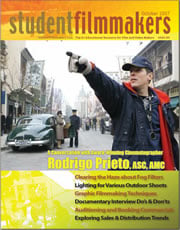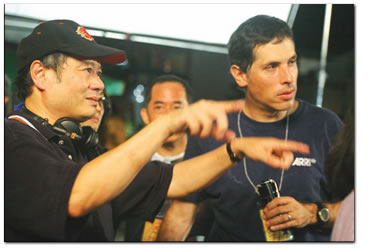Check out this article in the print edition of StudentFilmmakers Magazine, October 2007. Click here to get a copy and to subscribe >>
 A Conversation with Award-Winning Cinematographer Rodrigo Prieto, ASC, AMC A Conversation with Award-Winning Cinematographer Rodrigo Prieto, ASC, AMC
by Jacqueline B. Frost
So Julie Taymor is the only woman you�ve worked with so far?
Rodrigo Prieto, ASC, AMC: My second film was also with a female director. Here name is Eva Lopez-Sanchez, and the film was called, �Dama De Noche.� With Julie, it was very exciting to do �Frida� because it was very collaborative. We shot listed the whole movie together. We would also have meetings with the production designer and several people involved, and talk about all the things that were not scripted, transitions, paintings turning into reality. Many of those transitions we worked on together. She is incredibly creative, and she�ll come up with these amazing ideas. But she is open to listening to all of our ideas too. It was really exhilarating.

Ang Lee and Rodrigo Prieto, ASC, AMC working on the set of "Lust, Caution".
What would the first meeting for a potential project be like with a director?
Rodrigo Prieto, ASC, AMC: One of my first meetings like that was for Michael Cristofer for �Original Sin.� I really wanted to do a period movie, something totally different then �Amores Perros.� No one knew me at that time, so I was nervous. I try not to worry if I�m going to get the job or not, so I just go in and say what I think about the script, about the project. Even if there are things that are not working with the script, I�ll say it, even at the risk of not getting the job. I figure if there is something that I really feel strongly about, then why do it? Usually a director will say, yeah, we�re working on that, or yeah, or whatever. It�s a way of showing I�m honest about my feelings about a project, and I won�t shy away from my opinion. But I am not a person who will be stubborn. I just point out what I think.
My second big interview was with Oliver Stone for �Beyond Borders.� Which, in the end, he did not direct, but we did some prep work, some documentary footage in Africa. I expected an intimidating interview. I found out the day I went in, so I didn�t have a chance to get nervous. The chemistry was great. I felt very comfortable with him. I thought he was going to tear me apart, but he didn�t. We watched some clips from �Amores Perros,� and he told me about his project. And I think I was fortunate to have good interviews like that early in my career.
Curtis Hanson was interesting because he interviewed me like four times before he gave me the job. He was very deliberate about the process, and he wanted to make sure I was the right person for the project. He had seen a lot of my early Mexican movies, so he was familiar with my work before �Amores Perros.� I was working on a whole different style then, reacting to the aesthetics of the movies of the 70�s. What I was doing was more stylized with deliberate lighting, more beauty lighting. Curtis did not want that for �8 Mile�, and kept asking if I would fall back into that. I assured him that I didn�t do that in �Amores Perros,� and that I would light for the style of the film, and eventually he agreed to hire me. He just wanted to be sure the look for �8 Mile� would be very naturalistic and gritty.
What attracts you to a project creatively?
Rodrigo Prieto, ASC, AMC: One thing is the challenge; I look for a new challenge. I tend to choose projects that are different than the one I did before. Although it�s not so much on purpose, I have to find something in the script that is close to me in some way, or close to my heart or something that I�m interested in exploring. Almost as if it would be something I would direct as well. So far, I have never chosen a project as a job. It�s always been something I want to participate in for many reasons. The experience of �8 Mile�, with Rap music Detroit, was interesting to me, learning about it. Same with �Alexander� or Ang Lee in China. When I decided to do �Lust, Caution,� there were other interesting projects to choose from, but choosing that movie was, of course, the collaboration with Ang Lee. And also being in China, and learning about the Japanese occupation after the war, something I was not aware of. It�s really very interesting. You have to dive into these worlds. So all of those are elements of choice. It�s also balancing my work with my family life, to be near by family. Now I�m doing a movie that more than half will be shot in LA, so that�s another factor. But mostly it�s about my heart telling me this is something I want to do right now.
What if you don�t like the script?
Rodrigo Prieto, ASC, AMC: I read a lot of scripts, and I won�t even finish it if it is not talking to my heart. Genre is important also, I try to dip my feet into all sorts of different genres. I did turn down a movie recently because it was a classic Western, and I don�t like Westerns. The script was really good, it had cowboys, shoot outs, everything, a classic Western genre film. I don�t go and see Westerns, so if I�m going to do a movie, it is one I would go see in the cinema. Who knows, maybe later in life I will change my mind and do a Western? [laughs]
What attributes do you like in a director?
Rodrigo Prieto, ASC, AMC: For me the most important thing is passion. And a director who is not passionate about his project turns me off. That means sometimes I work with directors who will really challenge me and the crew, and we will work long hours, and it�s tough. But I much prefer that, to someone who just wants to get it done in a reasonable amount of time and go home, just get it in the can. So passion is the most important thing.
What kind of visual references have you used in communication with a director, or a director has used to communicate with you?
Rodrigo Prieto, ASC, AMC: Curtis said he wanted �8 Mile� to look like� weeds growing out of a sidewalk.� I think a big part of the color palette came from that, lots of cyans. With �Alexander� for example, I presented Oliver with a set of scanned photographs and paintings with references of color, composition, grain, and lighting, including photos of Sebasteao Salgado, and paintings from Rembrandt and Caravaggio.
For �Amores Perros,� when Alejandro presented the script to me, we had worked together on many commercials before, in this sleek style, precise lighting. He knew my past work, and he was afraid I wouldn�t want to do gritty dirty movies. So I read the script and came in to our first meeting to talk about the visuals with a book from Nan Goldin that I had recently discovered. Alejandro had the same book with him as a reference, and he said you may not like this, but here are some references for the movie. And I pulled out the same book, so our starting point was the same. For �21 Grams,� we used some Nan Goldin and Laura Letinsky on �Babel.�
Do you expect or like a director to know specific focal lengths and understand depth of field?
Rodrigo Prieto, ASC, AMC: It helps that they do understand technical aspects, but it is not essential. I see advantages of both cases. When I worked with Julie Taymor, she had already done �Titus,� and she had a certain language of film, but she wasn�t extremely technically savvy. But I think it helped because she would come up with ideas that weren�t constrained to the traditional limitations that you think of the way you shoot something, or visual effects or whatever. So then, I had to figure out technically how to achieve her idea. So I tried very hard not to limit her by saying that would be really difficult because of this and that � okay, this is what she wants, and how do we do it? So, it was exciting, and I think in that case, it was to our advantage that she didn�t know the limitations that technique will put in her brain. There is always a way to achieve something.
But Ang Lee, for example, he is very technically savvy. Most of the directors do understand focal length, they are very experienced, but for Ang the subtlety between a 32mm and a 28mm is a big deal for him, one filter versus another, so he�s very aware of the subtle differences. If I show him the difference between one film stock and another, he will see the differences; other directors may not, so sometimes you have to present them the differences that are bigger. Such is the case with Oliver Stone, he is not about subtlety, when you propose something it has to be bold and he has to see it, it�s interesting, both ways I enjoy, it�s just a matter of jiving with a director.
|